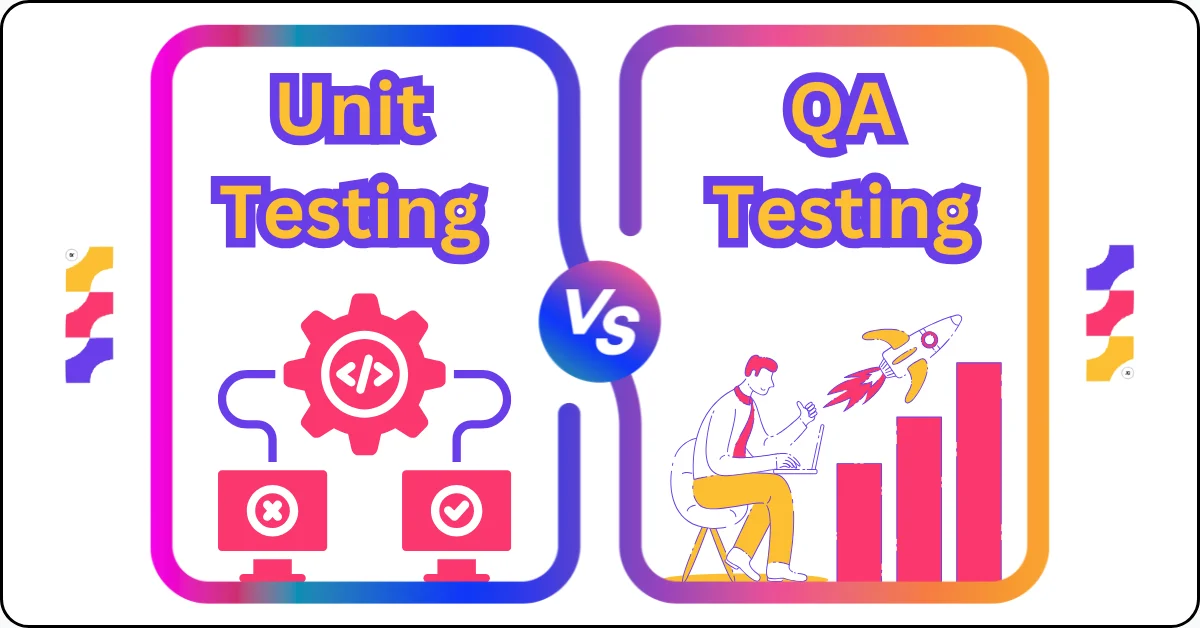
Multisyn Tech Pakistan’s premier software development firm delivers rapid MVP development, high‑performance web and mobile apps, cloud‑native SaaS products, and scalable custom software. Our agile teams validate, build, and optimize your idea fast with expert UI/UX, QA, and DevOps, so you launch sooner and grow faster.
Introduction
The software development lifecycle depends on a crucial stage where the product must meet its expected functionality. Before software reaches end-users, testing is essential, permitting developers and QA testers to locate and solve program defects. Businesses rely on two key testing methods: unit testing and quality assurance (QA) testing. The two testing methods aim to deliver high-quality software, but they operate differently and focus on distinct aspects. This article will explore both methods and show how they complement each other for superior product quality.
What is Unit Testing in QA?
Unit testing is an approach to testing that checks individual software components or units independently from other program elements. Each distinct segment of software code that functions as an independent entity is known as a "unit," but methods and functions are the most common units for testing. Unit testing serves a basic purpose by confirming that each code segment functions correctly.
The developers execute unit tests within the coding phase to validate the correct operation of individual function components. Several testing frameworks enable automatic unit testing, including JUnit for Java programmers, PyTest for Python users, and NUnit for the .NET development environment. Automation of unit tests provides developers with fast bug detection tools for individual code pieces, which helps minimize early errors and maintain error-free code modification.
What is QA Testing?
QA Testing represents a comprehensive testing methodology that examines the entire software quality from a broader perspective. It evaluates the complete software functionality to ensure that all specifications regarding requirements operate smoothly alongside performance standards. QA testing follows unit testing by checking for functional testing, integration testing, system testing, and acceptance testing.
The primary purpose of QA testing is to detect all differences between actual outputs and predefined results throughout an application. QA testers devote their attention to evaluating software usability, security, and performance while ensuring the end product fulfills stakeholder and user standards. Specialized QA tester and quality assurance engineer usually conducts this testing.
Similarities Between Unit Testing and QA Testing
Although unit testing and QA testing differ in many aspects, they share some similarities, which are important to understand.
- The goal of Improving Quality: Both unit testing and QA testing aim to deliver high-quality software that works as expected, is free from bugs, and meets the end-user's needs.
- Error Detection: Both methods help in the early detection of errors. Unit testing helps detect issues within individual components, while QA testing helps identify larger issues within the entire application.
- Automation Possibilities: Both unit testing and certain aspects of QA testing (e.g., regression testing) can be automated, improving efficiency and reducing manual effort.
- Continuous Process: Both testing types should be performed continuously throughout the software development lifecycle to ensure consistent quality assurance.
Unit Testing vs QA Testing: Key Differences Explained
Unit testing vs QA testing: While both ensure software quality, they differ in execution methods and testing boundaries.
Scope:
- Unit Testing: Focuses on the smallest components of the software (e.g., individual functions or methods).
- QA Testing: The testing process covers the complete software system by examining overall component interaction and integration.
When They are Performed
- Unit Testing: Programmers execute unit testing directly after writing a source code unit during the coding development phase.
- QA Testing: QA Testing takes place following unit testing to evaluate the software at a later stage when it reaches a more stable condition.
Who Performs the Testing
- Unit Testing: During unit testing, developers mainly test their code to ensure proper functionality.
- QA Testing: QA testing is performed by external personnel like QA engineers or testers who conduct evaluations without development involvement.
Testing Focus
- Unit testing: The unit testing framework consists of functionality tests which confirm that independent units function correctly.
- QA Testing: Focuses on overall software behavior, user experience, integration between components, performance, security, and compliance with business requirements.
Automation
The testing process based on Unit Testing uses specialized unit testing frameworks to automate testing throughout continuous integration.
QA Testing includes both manual evaluation for system usability alongside automated regression assessment but still depends on human testers to handle subjective quality aspects.
The Relationship Between Unit Testing and QA Testing
Delivering high-quality software to users requires the necessary elements of unit testing and QA testing to work together as one cohesive system. Unit tests discover system flaws at component level before QA testing identifies complete system functionality problems and user experience and performance issues.
Software development excellence depends on implementing unit and QA testing with maximum diligence. The first testing stage should be unit testing since it verifies the basic elements of the application work properly. The testing process moves to QA evaluation to verify that all program components function together as users expect.
Customer Success Story: How Multisyn Helps Clients Achieve Exceptional Quality
By implementing Multisyn's testing, the company reduced customer complaints by 40% and improved system uptime by 99.9%. Our expert QA testing ensured flawless user experience and increased revenue.
The company could realize rigorous unit testing through their partnership with Multisyn, which enabled them to check that each software component functioned correctly. Our team executed a complete QA evaluation with performance evaluation, security evaluation, and user acceptance evaluation to provide a flawless user experience for the platform. The client achieved better user satisfaction while receiving fewer customer complaints and increased sales performance.
Conclusion
Software development requires both unit and QA testing as fundamental elements supporting each other to guarantee software quality. The main distinction between unit testing and QA testing exists in their different scope as unit testing checks individual components, but QA testing verifies complete application functionality. Software developers and QA teams achieve improved product quality by combining unit testing with QA testing approaches during their evaluation process.
Our testing services at Multisyn are designed to fulfill individual client requirements exactly. Our commitment extends to providing either unit or QA testing or both to help you develop high-quality software that produces user satisfaction and business growth. Contact us today to learn how our unit and QA testing can improve your software development process!
FIND US:
Multisyn Tech Pakistan’s premier software development firm delivers rapid MVP development, high‑performance web and mobile apps, cloud‑native SaaS products, and scalable custom software. Our agile teams validate, build, and optimize your idea fast with expert UI/UX, QA, and DevOps, so you launch sooner and grow faster.
Related Blogs

© 2025 MULTISYN TECH



